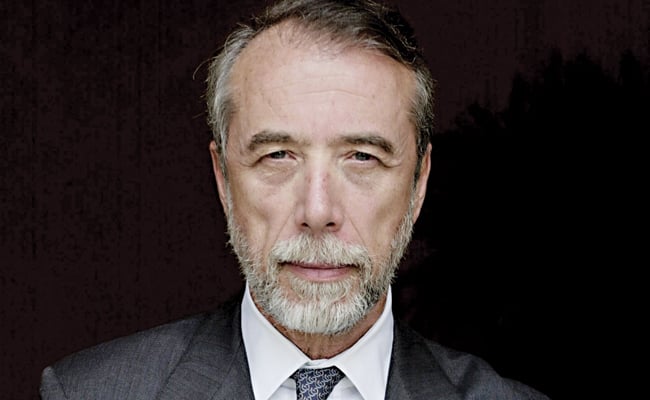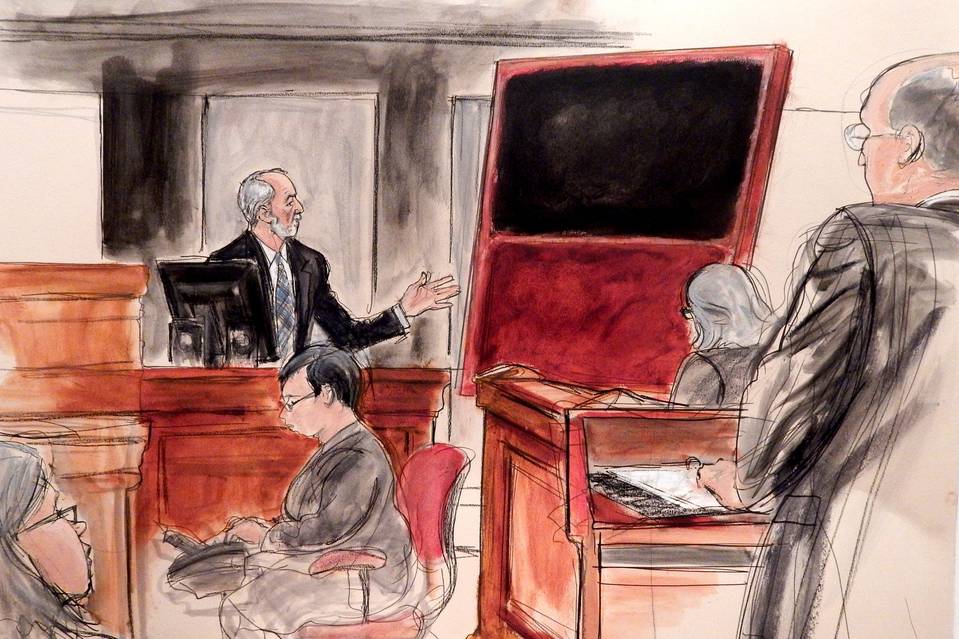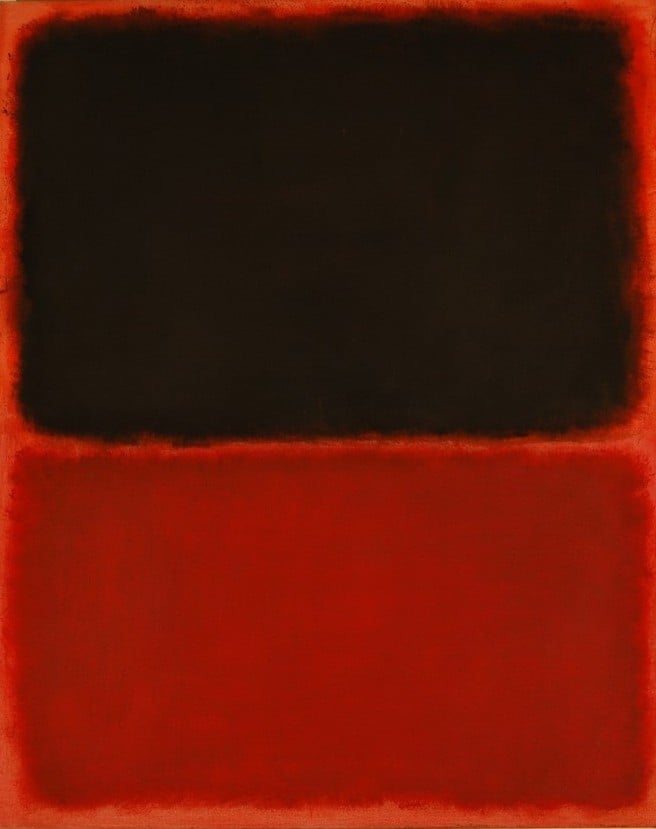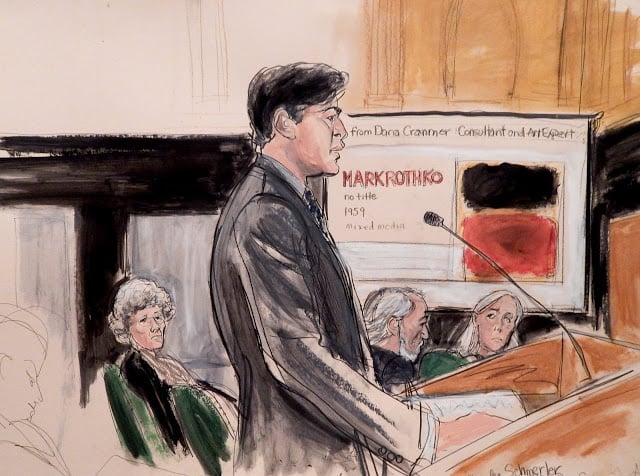Galleries
Sparks Fly at Knoedler Trial as Defrauded Buyer of Fake Rothko Painting Takes Stand
Domenico De Sole demands his money back.

Photo: Courtesy of Sothebys.com
Domenico De Sole demands his money back.

Eileen Kinsella

“I got a fake painting for $8.3 million and I want my money back!” proclaimed a visibly angry Domenico De Sole in federal court in Lower Manhattan today. He simultaneously gestured aggressively at a large red painting set up on an easel just inches away from where he sat on the witness stand.
De Sole, a former Gucci executive and chairman of Sotheby’s board, along with his wife Eleanor, are the plaintiffs in the only Knoedler forgery trial to make it to court so far. And the stakes are high.
The De Soles are among dozens of buyers who spent six-, seven-, and even eight-figure sums on paintings purported to be by top-notch Abstract Expressionists but which actually turned out to be the work of an amateur painter in Queens, New York.
Knoedler’s former president, Ann Freedman, and attorneys for Knoedler & Co. appeared on the defendants side.
Having spent over $8 million on a work he and his wife believed was by Mark Rothko, the De Soles are seeking $25 million in damages. Noting that he “worked very hard” for the money that he spent, and calling what happened at Knoedler “a conspiracy,” De Sole said, “I think we deserve a lot of damages.”
Throughout his testimony, De Sole repeatedly emphasized the trust he had placed in both Freedman and Knoedler, the “oldest gallery in Manhattan,” and one of the most prestigious in the country.

A courtroom sketch of Domenico De Sole on the witness stand with the fake Rothko painting he bought from Knoedler gallery.
Photo: Elizabeth Williams, courtesy ILLUSTRATED COURTROOM.
Asked about due diligence attempts by his attorney Greg Clarick during direct examination, De Sole recounted the steps he had taken, including asking Freedman for written evidence of the numerous verbal representations that she made, including that the Rothko painting was owned by the heir of a secretive Swiss collector referred to as Mr. X, who had residences in Mexico and Switzerland and who had acquired the work directly from artist’s studio with the help of art adviser David Herbert.
Freedman did provide these representations in writing, and De Sole was satisfied with this as well as with her assertion that the work had been reviewed by a number of Rothko experts, including the artist’s son, Christopher.
But when it turned out that Glafira Rosales, the Long Island dealer who brought more than 40 works to Freedman at Knoedler, had concocted the story and that there never was a “mystery” collector, such guarantees instantly became worthless.
This trial and numerous other related Knoedler forgery cases are raising serious questions about what constitutes a binding guarantee of authenticity and how much due diligence both buyers and sellers are responsible for conducting.

A painting sold by Knoedler as a Mark Rothko that turned out to be fake.
De Sole at one point referred to the painting as “worthless.” On more than one occasion when Clarick asked about his research efforts, De Sole said that, notwithstanding his own efforts at documenting what he was told was the ownership history, “I never had any reason to believe [Freedman] was lying to me.”
“It was millions of miles from my mind,” he said, “that this could ever be a fake and that Knoedler was selling fakes.”
The appearance of the forged painting itself in the courtroom was something of a surprise. The De Soles’ attorneys carted it haphazardly across the the courtroom immediately before his testimony—a startling contrast to the cautious white-glove treatment usually given to authentic blue-chip works by uniformed art handlers at auction—and propped it up on a large easel.
Lawyers for both plaintiffs and defendants then spent several moments having sidebar discussions with Judge Paul Gardelphe about the forged work and examining the back—but it was not immediately clear what the discussion or disagreement was about.
Perhaps as evidence of the painting’s contentious presence, when a Knoedler attorney stepped up to cross examine De Sole, the painting was taken off the easel.
Earlier in the day’s proceedings, Clarick spent a good deal of time questioning Melissa De Medeiros, a researcher who acted as Freedman’s assistant at Knoedler.
The lengthy question-and-answer session, as well as the documentation provided, painted a startling picture of the timeline of the events beginning with the moment that Rosales was first introduced to Freedman at the gallery by the former staffer Jaime Andrade. Memos presented by the attorneys revealed how the number of works proffered from the “mystery” collection seemed to steadily increase over time, from fewer than ten to more than 40.
De Medeiros also described how her research efforts supported both what Rosales initially told Freedman and the story that the gallery eventually offered to prospective buyers. This information helped explain to buyers how Mr. X’s collection was assembled, even though that tale, as relayed and presented by the gallery, changed over time.
An essential part of the story about Mr. X’s collection was that Filipino-born artist Alfonso Ossorio facilitated many of the cash acquisitions by the supposed Swiss collector directly from the artists’ studios, and with no documentation. The gallery eventually came to put the name of David Herbert, a well-known dealer and art adviser, on the Rosales-sourced paintings.

A courtroom sketch of defense lawyer Charles Schmermer at the Knoedler gallery trial.
Photo: Elizabeth Williams, courtesy ILLUSTRATED COURTROOM.
Clarick pressed De Medeiros repeatedly about whether, in her extensive research, she had ever uncovered a single document that connected Ossorio or Herbert to a Swiss private collector or to a Mexican private collector. He also persisted in trying to suss out the timing of when she started researching each name as a possible connection to Mr. X.
After De Medeiros repeatedly gave vague answers, including one in which she described an exhibition that Ossorio had organized in Paris and a list of attendees she had uncovered, it was Judge Gardephe who finally cut to the chase, turning to De Madeiros and saying, “I’m not asking you about attendees at an exhibit organized by Mr. Ossorio.”
Shortly afterwards, he questioned De Madeiros again. “Did you find any documentation of Mr. Herbert advising a Swiss collector?”
De Madeieros at this point—somewhat inexplicably—brought up the name of the well-known late Swiss collector Ernst Beyeler.
“Let me say it again,” Judge Gardephe said pointedly. “My question is, Do you recall any documentation that David Herbert was advising a collector who lived in Mexico and Switzerland?”
De Madieros said she did not recall any.
Another tense moment during the morning session came when Clarick asked De Madeiros about the previously reported detail that Freedman and other gallery staffers referred to Mr. X—whose supposed collection of Abstract Expressionist masterpieces netted the gallery tens of millions of dollars over the years—as “Secret Santa,” a practice that the New York Times reported on in 2012.
Clarick asked if the phrase “Secret Santa” had been used in connection with Rosales’s collector. When De Madeiros responded affirmatively, he then asked, “Who used it?”
“I remember Ann Freedman using it,” replied De Madeiros.
When Clarick next asked her what “Secret Santa” typically means, De Madeiros responded, “It’s a phrase that refers to anonymous gift-giving at holidays.”